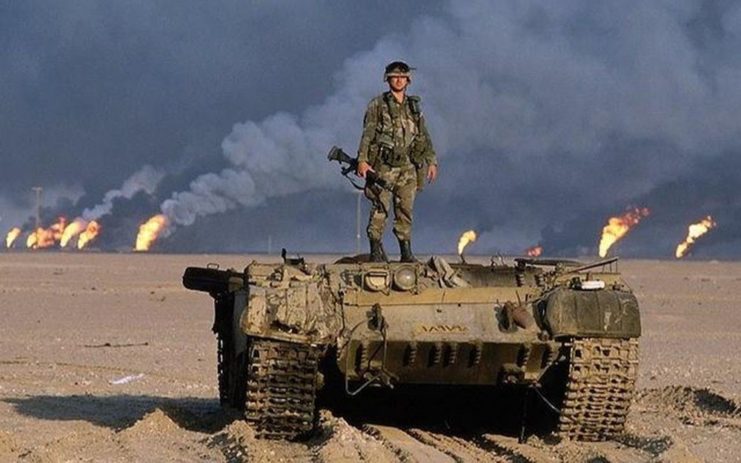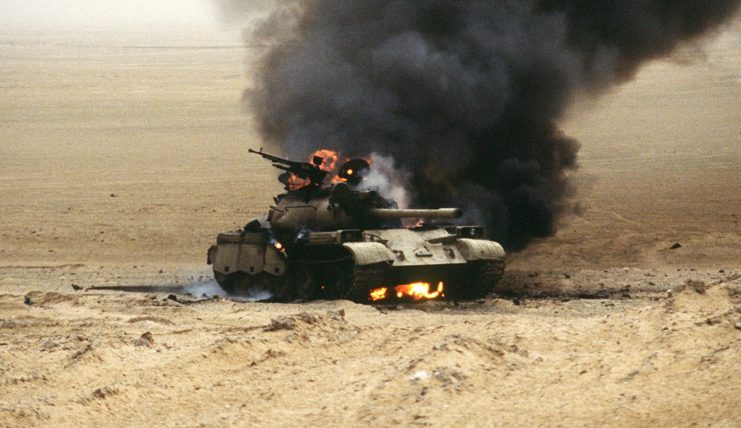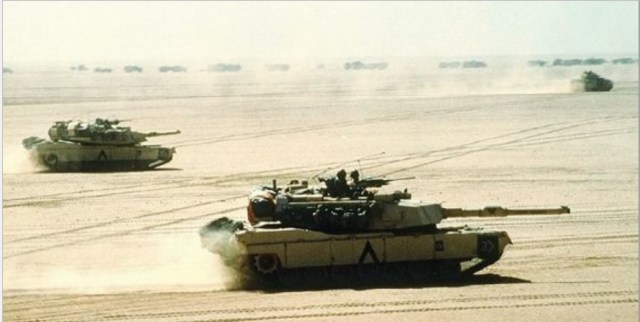In 1991 the Gulf War set the stage for a large-scale tank battle that pit the US’ M1A1 Abrams main battle tank (MBT) and supporting vehicles against a numerically superior force. When US tanks found the bulk of Iraq’s armored vehicles sitting unprepared in the desert, the ensuing battle was a turkey shoot for the American vehicles. This dominating display of power over the mostly Russian-sourced tanks is often described as “the last great tank battle of the 20th century.”
Lieutenant General Herbert Raymond McMaster (now retired) played a major role in the Battle of 73 Easting. Recently, he served as the United States National Security Advisor, but back in 1991, McMaster was the captain in command of Eagle Troop, 2nd Squadron, 2nd Armored Cavalry Regiment (ACR).
Iraq invaded Kuwait in August of 1990 and placed a huge portion of the Western world’s oil supply in jeopardy, triggering the Gulf War. By mid-December, the 2nd ACR was already in Saudi Arabia preparing to fight.
Battle of 73 Easting

Eagle Troop was comprised of nine M1A1 Abrams tanks and about 13 Bradley fighting vehicles. McMaster was commanding the lead tank.
While many of the tanks used by Iraqi forces were older designs, and their crews were poorly trained, US tankers were wary of the Iraqi Republican Guard. These elite troops were much better trained and operated much newer equipment and posed a real threat to Coalition forces.
On February 24 1991 US ground forces entered Iraq to the shock of Iraqi troops. At this point, Iraq’s forces had endured weeks of heavy bombardment and their fighting ability was severely reduced.
The 2nd ACR, and therefore Eagle Troop, as explained by McMaster, were tasked with moving ahead of the main force to establish the location of the enemy and clear the way for the bulk of US forces.
The battle was named after a UTM north-south coordinate line that served as a phase line to measure the progress of the attack.
As they made their way through the desert over the next few days, they made contact with a number of Republican Guard scouting parties. This essentially blinded the Iraqi forces, who were from then on unable to establish the location of US forces.
The 2nd ACR’s powerful M1A1 Abrams were following close behind their Bradleys, which were equipped with thermal imaging sights to help cut through the low-visibility desert.
On the morning of the 26th of February, the 2nd ACR was instructed to now head east instead of northeast. Poor weather had limited aerial reconnaissance, and a sandstorm during the day ensured the enemy positions were not known.
As he pulled up onto a deceptive ridge in the desert, McMaster realized he had come across an entire division of dug-in Iraqi tanks. The commander of the vehicles had set up a good defensive position, with his tanks waiting for US forces to crest the ridge, at which point their exposed upper armor would make them easy pickings.
This idea was great on paper, but without any reconnaissance parties, the Iraqis were quite literally caught with their pants down. Falling back to his training, McMaster opened fire, instantly destroying an enemy tank. His tank’s second shot destroyed a second tank.
Within seconds, McMaster had destroyed two enemy tanks and was now joined by the other eight M1A1 Abrams in Eagle Troop. Together, they fired on the enemy with fury.
The Bradleys attacked the Iraqi tanks with their TOW missiles and scattered their troops with mortar and machine gun fire.
As McMaster’s tank headed towards the enemy the driver realized they had entered a minefield. Anti-personnel mines tickled the belly of the tank as it rolled forward, firing as it went.
The rapid advance of Eagle Troop stunned the Iraqi forces, who were quickly neutralized.
McMaster and his men reached the limit of their advance, but he was aware that the enemy may be about to mount a powerful counterattack with their remaining reserve forces.
Ignoring orders he pushed on, overwhelming the final Iraqi tanks until there was nothing left to shoot. A few small engagements occurred in the moments after the battle, but the work of the 2nd Squadron was done.
Results

The entire battle had lasted just 23 minutes. In this time, 2nd Squadron had managed to destroy around fifty tanks, forty trucks, and twenty-five armored personnel carriers without taking any losses. The only noticeable damage caused by the enemy was to an M1A1 Abrams that had driven over a mine.
More From Us: Army Major Conned Nations into Sending Him Tanks & Weapons
After this one-sided battle, many Iraqi troops were ready to throw in the towel. US forces blasted appeals for the enemy’s surrender, to which hundreds responded. About 250 Iraqi soldiers surrendered to Eagle Troop alone.
Occurring just 9 years before the turn of the century, the Battle of 73 Easting is remembered for being the 20th century’s last great tank battle.
